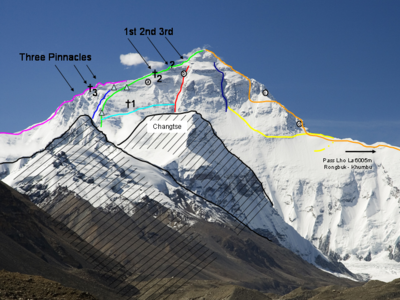Hornbein Couloir
The Hornbein-Couloir is a steep gorge high up on the north side of Mount Everest in Tibet , which delimits the summit pyramid to the west and extends to around 150 m below the summit.
The equivalent to the east of the summit is the Norton Couloir .
Naming
The steep gorge was named after Thomas Hornbein , a participant in the American Everest expedition in 1963.
Alpinism
The crossing of Mount Everest
Hornbein and his partner Willi Unsoeld took part in an expedition led by Norman G. Dyhrenfurth , which tried two ways to get to the summit from the Nepalese south side of Everest. The majority of the participants in the expedition used the same route that the first climbers Tenzing Norgay and Edmund Hillary had taken ten years earlier to climb through the Valley of Silence and the flank of the Lhotse to the south saddle and on over the southeast ridge to the summit.
Hornbein and Unsoeld, however, had stubbornly decided to continue the difficult attempt to get out of the valley of silence first through the unclimbed south-west face to the west ridge, and then to use the previously equally unclimbed, steep and extremely demanding west ridge for a summit attempt. When, on May 22, 1963, high up on the ridge that marks the border between Nepal and Tibet, they could no longer proceed, they traversed into Tibetan territory into the north face and finally used this couloir for the final ascent to the summit. On this route, too, they encountered great difficulties, which made it hopeless to use the same route to descend again.
They did not reach the summit until around 6.15 p.m. hours before two of their expedition friends had arrived from the south side, Barry Bishop and Lute Jerstad. As darkness fell, they began the descent. They followed their comrades over the Hillary Step down to the southeast ridge and found them exhausted below the south summit at an altitude of about 8,600 meters, where the four set up for a grimly cold night of bivouacs, the highest-altitude overnight stay for people up to now. All four survived the night when, luckily, there was hardly any wind. However, Unsoeld later lost all toes as a result of frostbite.
Snowboard descent
In 2001, the young French extreme snowboarder Marco Siffredi planned a descent through the Hornbein Couloir, which, with an incline of 45 to 50 °, is considered to be the most technically demanding potential route on the north side of Everest. Due to moderate snow conditions, he had to switch to the easier Norton Couloir to the east . The following year he tried to make up for his failure, but had an accident on departure. Whether he even made it into the couloir and was caught by an avalanche is the subject of speculation. His body has not yet been found.
literature
- Thomas Hornbein: Everest - The West Ridge.
Individual evidence
- ^ Trey Cook: The Disappearance Of Marco Siffredi. snowboarding.transworld.net, September 8, 2013, accessed on August 16, 2017 .
